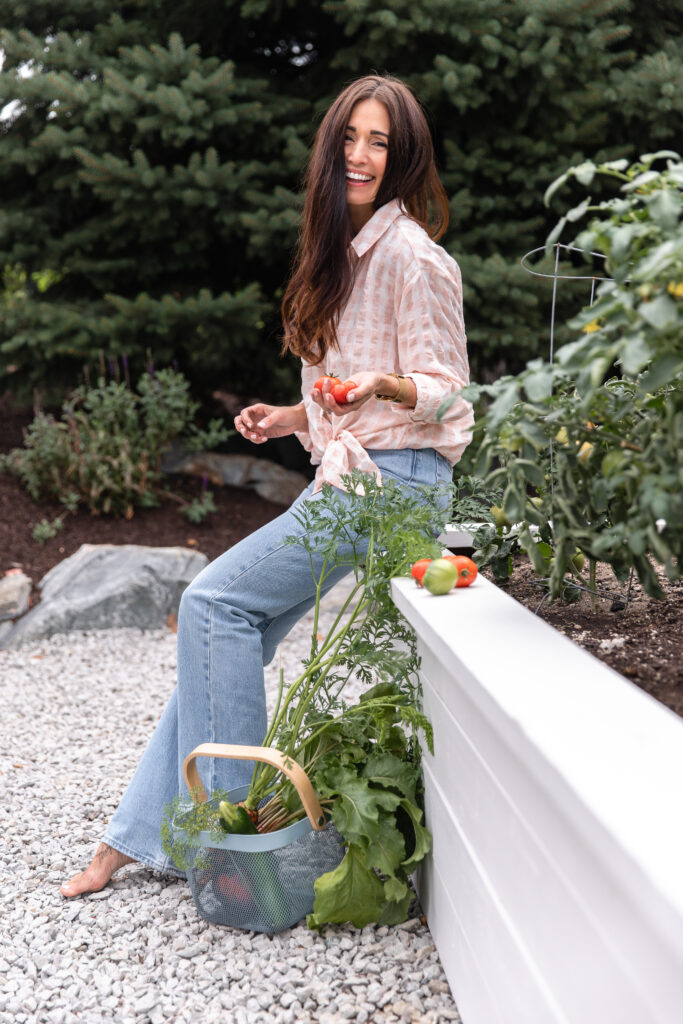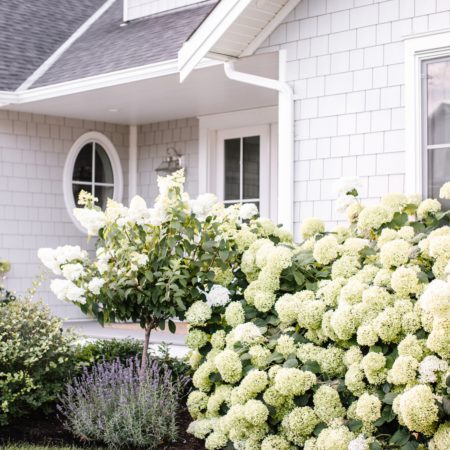Get out your gardening gloves! Here are all the tips and tricks on how to plant a vegetable garden. No green-thumb required!
Have you always dreamed of having your own mini produce section right in your own backyard? I’m here to help! There is nothing more rewarding than enjoying the fruits of your labour all season long with fresh, delicious veggies. With the help of Ariel Walisser (from Ariel Home & Garden), we’ve put together a guide to help you plant your very own vegetable garden.

Choosing the Right Location for Your Garden
You know what they say? Location, location, location! Here are some important things to take into consideration when choosing a location for your vegetable garden:
- Sunlight: Select a spot that receives ample sunlight throughout the day, ideally at least 6-8 hours of direct sunlight. Most vegetables thrive in full sun, although a few leafy greens can tolerate partial shade!
- Water Source: Ensure your chosen location is easily accessible to a water source. Having a nearby water supply will simplify irrigation and reduce the effort required to water your vegetable plants. Charles ran water lines to each of our garden beds with irrigation which is admittedly a life saver, but a hose and spray nozzle will work just fine.
- Soil: Not all soil is created equal. Choosing the right soil for your vegetable garden is crucial for the success of your plants. Here are some guidelines to help you select the appropriate soil:
- Nutrient-rich, loamy (balance of sand, silt and clay) soil: Look for soil that is rich in organic matter, such as compost or well-rotted manure, to provide nutrients and structure.
- Well-drained soil: Avoid soil that is heavy in clay, as it tends to hold water and can lead to root rot. We added gravel at the bottom of our raised garden beds to support drainage.
- Consider raised beds or containers: If your existing soil is of poor quality or if you have limited space, consider using raised beds or containers with high-quality soil. This gives you more control over the soil composition and is so much easier to maintain!



Planning Your Vegetable Garden
I spend far more time planning my garden than I do actually planting it. There is a method to the madness, and let me tell you, I’ve planted my share of chaotic gardens! Here are a couple of rules of engagement for best results:
- Less is more. Wow, are those words I am actually typing? I am a chronic over-planter, but practiced incredible restraint this year and am rather proud of myself. Because apparently there is such a thing as too much zucchini, go figure. Follow the directions on the seed packages for best results, and leave plenty of space for things to grow. Charles will LOL when he reads this for the record, I’m the worst at over-planting. Call it gardening FOMO.
- Not everyone in the garden gets along. Keep dill away from carrots, but rumour has it cucumbers love nasturtiums (also edible). THE DRAMA! High-school has nothing on my garden. This blog isn’t long enough to get into it all, but if you want to learn more I found this article useful.
What is Companion Planting?
Companion planting is a gardening technique that involves strategically planting different plants together to maximize their mutual benefits. It involves selecting plant combinations that support each other’s growth! Now, isn’t that the cutest thing ever? This article is a good resource for getting started with companion planting.

Tomato Planting Tips
- Planting: When it comes to tomatoes, check plant heights before planting! You want the tallest variety in the middle, and shortest on the outside edges, and plant the tomatoes 2-3 feet apart. Pay attention to the varieties: what are you using them for? Salads, sandwiches, veggie trays, pasta sauce… ? Each variety has its own characteristics. Lastly, plant once the last frost has passed (optimal temperature for planting is around 15 C).
- Watering: Water tomato plants deeply and regularly, but don’t water-log the soil as it will lead to root rot. Avoid overhead watering, as wet foliage can promote diseases. Water at the base of the plant to keep the leaves dry.
- Support: Use sturdy cages or stakes for tomato plants, and place them around the plant early in the growing season.
- Companions: Basil and marigolds are super companion plants for tomatoes! Plant them in little clumps of three around the base of tomato plants.
- Pruning: Pinch off suckers or small shoots that appear between the stem and the main branches to maintain air flow and allow the plant to focus on the fruit-bearing stems.
Types of tomatoes (Basically stripper names LOL):
- Beefsteak
- Sun Sugar
- Early Girl
- Sweet Million
- Mountain Majesty
- Russian
- Early Girl Bush
- Celebrity
- Tiny Tim
- Manitoba


Essential Tools for Vegetable Gardening
Here are some tools I always make sure I have ahead of gardening season!
- Hand Trowel: This versatile tool is perfect for digging small holes, transplanting seedlings, and loosening soil in tight spaces.
- Garden Fork: Ideal for aerating your soil and turning compost, a garden fork helps improve drainage and promotes root growth. Note: you won’t need this for raised beds.
- Pruning Shears: Used for trimming and shaping plants, pruning shears are vital for maintaining the health and productivity of your vegetable plants. Make sure they are sharp.
- Garden Hoe: This tool helps you break up soil, remove weeds, and create furrows for planting seeds or seedlings.
- Watering Can or Hose: Proper hydration is crucial for healthy vegetable plants, so invest in a reliable watering can or hose for efficient watering.
- Garden Gloves: Protect your hands with a good pair of garden gloves. Seriously, your fingers will thank you!

Vegetable Garden Care
You’ve planned, shopped, planted, and now it’s time to keep your new veggies alive! The most important thing is understanding proper vegetable garden care so all your hard work doesn’t go to waste!
- Set a watering schedule to help avoid under and over-watering (which can lead to root rot).
- Weed regularly. Weeds compete for soil nutrients and block precious sunlight from reaching your plants. And weeding is kind of therapeutic, if you ask me. But I’m one of those weirdos who doesn’t watch TV so you have the full story.
- Fertilize and mulch. Ok, I put this one in because I thought I should, BUT… I actually do neither of these things and my garden grows just fine.
Happy gardening my friends, and if you have any questions pop them below I will do my best to answer!
More Home & Garden
For more home and gardening blogs, checkout:
- How to Plant a French Herb Garden
- French Garden Landscaping
- Our Pool Reveal
- Tips & Tricks for Adding Plants to Your Home
- How to Revive Wilted Hydrangeas










Maybe you could comment on the material of the boxes and why you painted them white, and what paint you used that’s non toxic so it doesn’t bleed into your vegetable plants.
Hi Charlene,
We used cedar, and didn’t paint the inside of the boxes: we also have garden (black) liner that is used for garden beds lining the boxes on the inside which is what contains the dirt and is a barrier between the wood and the soil. Take care, Tori
Do you have your garden box plans anywhere? (What you planted together in each box)
Hi Erin! I really should draw a little diagram… I will look into it for this year!! xx Tori